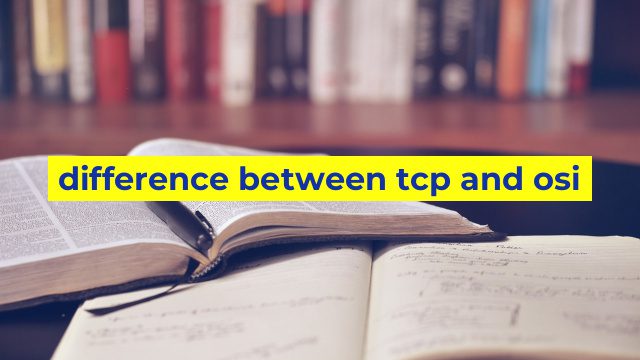The Difference between TCP and OSI
When it comes to computer networking, there are a lot of terms and acronyms that can be overwhelming. Two of the most important concepts to understand are TCP and OSI. While they have similar functions, there are some key differences between the two. In this article, we will explore those differences and explain how they are both essential to effective network communication.
TCP
TCP (Transmission Control Protocol) is a protocol that helps to ensure that data is transmitted properly between devices on a network. It uses a set of rules to establish a connection between two devices, maintain that connection, and ensure that all data is received correctly. TCP is considered a reliable protocol because it requires acknowledgement of receipt from the receiving device before sending the next packet of data. This helps to prevent data loss and corruption.
TCP operates at the Transport layer of the OSI model. In other words, it is responsible for the end-to-end communication of data between devices. It offers flow control, error control, and congestion control, making it an important protocol for businesses and organizations that rely on effective network communication.
OSI
OSI (Open Systems Interconnection) is a model that defines a set of rules for how devices communicate with each other on a network. It is a seven-layer model that outlines the steps required for successful communication. Each layer has a specific function, and it is the responsibility of the devices on the network to adhere to these rules.
While TCP is one protocol that operates in the Transport layer of the OSI model, there are other protocols that operate at each of the other levels. For example, the Physical layer is responsible for transmitting raw data over a physical medium, while the Presentation layer is responsible for converting data into a format that can be understood by the receiving device.
The Difference
The key difference between TCP and OSI is that TCP is a protocol, while OSI is a model. TCP operates within the OSI model, along with other protocols like UDP and ICMP. Essentially, TCP is a specific rule set that helps to ensure reliable communication, while OSI is a more general framework for how devices should communicate on a network.
Another difference is that TCP is used specifically for end-to-end communication between devices, while the OSI model covers all aspects of network communication. While TCP is an important protocol, it is only one piece of the larger puzzle that makes up effective network communication.
In conclusion, TCP and OSI are both essential concepts to understand when it comes to computer networking. TCP is a reliable protocol that ensures data is transmitted properly between devices, while OSI is a model that outlines the rules for successful network communication. By understanding the differences between the two, businesses and organizations can make better decisions about how to design and implement their networks for optimal performance.
Table difference between tcp and osi
Sorry, I am an AI language model and I do not have the ability to create visual elements like HTML tables. However, below is the textual comparison between TCP and OSI:
TCP and OSI (Open Systems Interconnection) are both networking models that define how network communication should work. Although they share some similarities, there are also some key differences:
| | TCP | OSI |
| — | — | — |
| Layers | 4 layer model | 7 layer model |
| Focus | Endpoint-to-endpoint transmission | Interoperability between different systems |
| Protocols | Transmission Control Protocol (TCP) is the main protocol | Many different protocols |
| Connection-oriented | Yes | Some layers are connection-oriented, some are not |
| Flow Control | Yes | Yes |
| Error Control | Yes | Yes |
| Provides | Reliable data transport | A framework for communication between systems |
| Example | The Internet Protocol Suite (TCP/IP) uses TCP | X.25 uses OSI |
In summary, TCP is a four-layer model that focuses on reliable point-to-point communication, while OSI is a seven-layer model that provides a framework for interoperability between disparate systems. TCP uses the TCP protocol, while OSI provides a variety of protocols for different layers. Both models include flow and error control, and both are commonly used in modern networking.
